Observations of Deep-Sky Objects
These are the observations made by amateur astronomers from around the globe. I'm keen to present the work of an observer (members or not) to further the aims of the Webb Deep-Sky Society. Images, sketches or even your observing notes are of interest.
If you have any observations of your own that you'd like to submit I'd be delighted to hear from you. Please try to include as much detail about the object (after all that's why we observe them) as possible. Time, date, location and observing conditions are useful.
We have observations of these Objects
Which fall into these classes
And these Constellations
Or if you'd just like to browse through our most recent observations
-
NGC 4365 in Virgo
Observations using 20 inch Dob in magnitude 5 semi-rural skies on the evening of the 29th March 2024. Seeing conditions were good with high transparency. These galaxies were approximately at 40 degrees altitude.
NGC 4365: Very bright object with large halo and obvious stellar core. Situated in between two bright field stars which enhanced the view using a 10mm Ortho eyepiece giving a magnification of 200x.
I then star hopped using the triangle of stars to the right of NGC 4365 on the map below to find a view with a trio of galaxies.
NGC 4342 was the brightest of the three galaxies in this eyepiece view frame. The galaxy could be seen with direct vision and was round in shape.
NGC 4343 was only visible with averted vision. The galaxy had a much lower surface brightness than 4342 and was oval in shape. A brighter core was noted.
NGC 4341 was only glimpsed occasionally with averted vision. It was extended in shape.
I was unable to see IC 3259 or IC 3267 or the nearby NGC 4309.
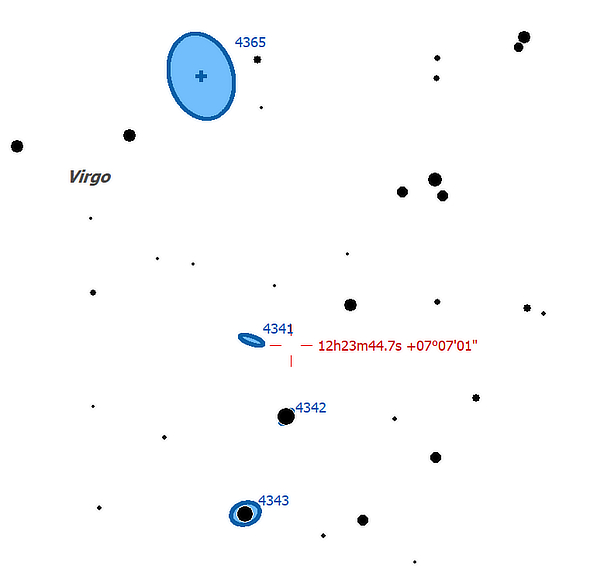
Observation chart of the area around NGC 4365 in Virgo. The field star and NGC 4343 / 4343 in a line made for a special view.
Mark Stuart - (29 March 2024).
-
Coddington's Nebula (IC 2574)
I managed to get out during the recent cold spell and imaged Coddington's Nebula, IC 2574.
IC 2574 is a faint dwarf spiral galaxy discovered by American astronomer Edwin Foster Coddington in 1898. It is located in Ursa Major and is an outlying member of the M81 Group. It is believed that 90% of its mass is in the form of dark matter. IC 2574 is about 50 thousand light-years across and located some 12 million light-years away. This galaxy is thought to resemble some of the earliest that formed in the Universe and are useful “living fossils” for studying the evolution of more complex galaxy types.
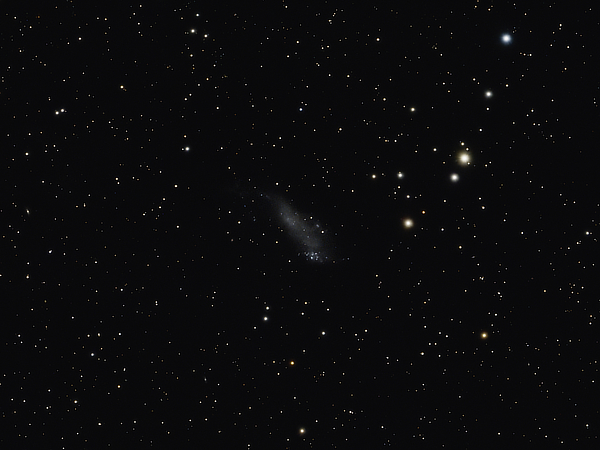
This image of IC 2574 in Ursa Major is by David Davies and taken from Cambridge in the UK. To see more of David's work please visit his Flickr Photostream. This galaxy proved to be a testing subject as it is quite faint with an integrated magnitude of 13 and a surface brightness of magnitude 23; individual sub-frames showed little more than a smudge against the sky background.
Image Details
Data: 45 x 180s RGB sub-images.
- Telescope: APM 107 refractor
- Camera: ZWO ASI 071 MC
- Mount: Skywatcher EQ8
David Davies - (24 January 2024).
-
Messier 32 and surroundings
M 32 is a small but bright dwarf galaxy close to M 31. Usually, people taking images of M 31 don’t concern themselves with M 32 and fix their exposures to see most of the fainter detail in M 31. Consequently, M 32 usually comes out as a small, bright blob. I've attached my full-frame image of M 32, correctly exposed to capture it at the expense of a much fainter M 31 behind.

This image of Messier 32 and its surroundings is by David Davies and taken from Cambridge in the UK. To see more of David's work please visit his Flickr Photostream. M 32 is something of an enigma. It appears to be a relatively rare compact elliptical galaxy, 6,500 light-years across, with a very high density of stars at its core and a supermassive black hole of more than half the mass of our Sagittarius A*. It contains older faint, red and yellow stars usually found in the core of a large spiral galaxy. One hypothesis, therefore, is that M 32 might be the remnant of a former spiral galaxy that lost its outer spiral arms in a previous encounter with M 31 about two billion years ago. If so, then what we see today is the remaining dense core of what was a much bigger galaxy.

A close-up crop of Messier 32 by David Davies. I've enjoyed inspecting the full frame image, especially the large star-forming region in M31, NGC 206 to the right of the frame. I've also searched for some of the many globular clusters in M31. The image below is a labelled crop from the main image showing four such clusters, including G76, one of the largest globular clusters visible to us in M31.

A labelled image of the larger Globular clusters in Messier 31 by David Davies. Image Details
Data: 40 x 180s RGB images.
- Telescope: 250mm Ritchey-Chretien
- Camera: ZWO ASI071MC
- Mount: Skywatcher EQ8.
- Software: NINA, Astro Pixel Processor, Pixinsight, Spectrophotometric Colour Calibration, BlurXterminator, NoiseXterminator, Photoshop
David Davies - (31 October 2023).
-
Supernova SN2023ixf in Messier 101
Finally, the clouds over East Anglia are breaking and revealing not one but two supernovae in familiar galaxies. A faint supernova in NGC4568 is now low on my southwestern horizon, and we also have the bright SN2023ixf in M101. The latest measurements on rochesterastronomy.org put the magnitude at 11.0. It is now so bright that only a 30s exposure produces an image which is not saturated, a 60s exposure, for example, is saturated.
I suspect many will have a go at M101 despite the lack of astronomical darkness. I captured the attached image on the 22nd and 23rd of May. The supernova is the bright star in the lower-right spiral arm at the eight o'clock location, close to the HII region NGC 5461. Unlike other stars in the image which are in our own galaxy and a few thousand light-years away, the supernova is 21 million light-years away.

This image of supernova SN2023ixf in Messier 101 is by David Davies and taken from Cambridge in the UK. To see more of David's work please visit his Flickr Photostream. A larger version of this image is available here. Image Details
Data: 35 x 120s RGB subframes.
- Telescope: 250mm Ritchey-Chretien with 0.7x reducer (1450mm focal length)
- Camera: ZWO ASI294MC Pro
- Mount: Skywatcher EQ8.
- Acquisition: NINA, GSS, PHD2
- Image Processing: Astro Pixel Processor, Pixinsight, Gaia Spectro-photometric Color Calibration using custom filters for the 294 camera, BlurXterminator, NoiseXterminator, Photoshop
David Davies - (23 May 2023).
-
Three in one: NGC 6712, IC 1295 and PK 25-4.1
The attached image resulted from something of an experiment to explore what quality of image I might get from using the ASI 294MC Pro one-shot-colour camera to try and capture two low-down, planetary nebulae.
My attention was initially drawn to the globular cluster NGC 6712, but an exploration of that region of the sky with a Cartes du Ciel revealed the planetary nebula IC 1295 close by with the Perek-Kohoutek object, PK 25-4.1 close by. I, therefore, elected to try my RC10 telescope with a 0.7x reducer (finally at its correct spacing) and with the telescope recollimated following some incorrect assumptions concerning the pointing accuracy of my TS_Optics focuser.

A 2x2 binned image of the globular cluster (NGC 6712) in a rich field of stars to the right of the image and IC 1295 to the lower left of the centre by David Davies. Taken from Cambridge in the UK. To see more of David's work please visit his Flickr Photostream. Click on the image for the larger version. NGC 6712 was discovered by William Herschel on June 16th, 1784. It is a relatively small (64 light-years across) and sparse (~1 million stars) globular cluster, which lies 22,500 light-years away.
A study by the European Southern Observatory concludes that NGC 6712 is only a pale remnant of a once much more massive cluster. It notes that none of NGC 6712’s stars is less massive than our Sun, making it totally unlike any globular cluster. Most likely, NGC 6712 is unique only because no other globular cluster comes as close to the Milky Way’s centre as NGC 6712; it penetrates very deeply into the galactic bulge, venturing to within 1,000 light-years of the galactic centre. The tidal force of the galaxy not only strips low-mass stars from the cluster but also stretches out the cluster like a comet’s tail. The ESO study labels NGC 6712 as a peculiar globular cluster. The Interstellarum Deep Sky Atlas labels 6712 as The Weird Globular.
Above is my 2x2 binned image of the full field which shows the globular cluster in a rich field of stars to the right of the image and IC 1295 to the lower left of the centre. I think I can see streams of stars running east of north and west of south from the globular cluster, as described in the literature.
Below is a full-resolution image of the region around IC 1295. IC 1295 is slightly left of the centre, and I believe that PK 25-4.1 is the small bright blue object in an arc of four stars to the upper right of the centre.
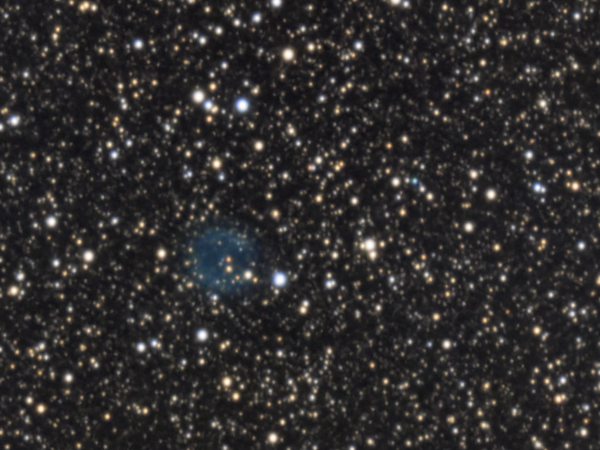
A full-resolution image of the region around IC 1295 by David Davies taken from Cambridge in the UK. Image Details
Data: 60 x 2-minutes exposures from 2nd to 6th October 2022.
- Telescope: 10-inch Ritchey Chretien with a x0.7 reducer at 1400mm focal length
- Camera: ASI 294MC Pro (-15C, gain 120, off 13)
- Mount: Skywatcher EQ8
- Software: NINA, Pixinsight, Photoshop
David Davies - (10 October 2022).
-
Galaxy NGC 5921 in Serpens Caput
Last night I wanted to try the galaxy NGC5921, proposed as the Galaxy of the Month. Hope you like it.
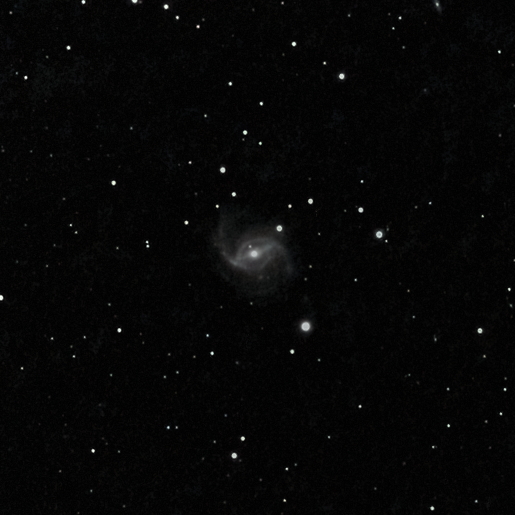
An image of NGC 5921 in Serpens Caput provided by Carlo Muccini and taken from Roma in Italia under Bortle 8 skies. Image Details
- Telescope: TEC 140.
- Camera: ZWO ASI 294MM camera with a Baader IR-cut filter.
- 4 x 900 second subs.
Carlo Muccini - (3 June 2022).
-
Messier 61 (NGC 4303) in Virgo
Astronomical darkness is now at an end for another season, but I have had a busy springtime imaging a number of galaxies. I've been using an ASI 294MC Pro camera and have overcome initial difficulties with achieving an acceptable colour balance and continue to be impressed with what this camera can achieve in relatively small exposure times. I've now reduced the camera gain setting to 50 to maximise the available well depth. This has reduced sensitivity but the end results still look good to me.
The Italian astronomer Barnabas Oriani discovered M61 on 5th May 1779 when he was following the comet C/1779 A1 Bode - it seems to me that several of the early discoveries of the galaxies of the Virgo Cluster are due to observers following this comet. He described M61 as
very pale looking and exactly like the comet
. Charles Messier found M61 the same night but mistook it for the comet and it was not until six days later that he realised his mistake, so M61 became another entry in his notes listing nebulae that could be mistaken for comets. Messier described M61 asvery faint and difficult to perceive
. It took Lord Rose and his 72" telescope to see some of the spiral structures of this galaxy.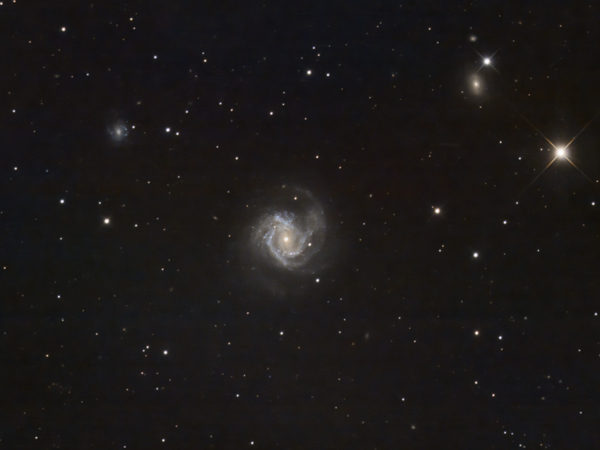
This image of Messier 61 (NGC 4303) in Virgo was provided by David Davies and taken from Cambridge in the UK. To see more of David's work please visit his Flickr Photostream. You can click here for a larger version of this image. I have found M61 to be quite a challenging target for my 8-inch telescope. With an integrated magnitude of 9.7 and 6' x 6' in size, the bright core contrasts with the quite faint spiral arms which hold lots of intriguing detail.
Image Details
50 x 2-minutes exposures (gain 50, offset 13)
- Telescope: 8-inch Ritchey-Chretien.
- Camera: ZWO ASI 294MC Pro camera.
- Mount: Skywatcher EQ8.
- Software: NINA, Pixinsight, Photoshop.
David Davies - (10 May 2022).
-
Supernova SN2022hrs in NGC 4647
A friend of mine alerted me to this supernova last night, and I dropped what I was doing and slewed the telescope to it. What a lovely sight. The supernova is the bright blueish star in the smaller of the two galaxies, M60 and NGC 4647, in the centre of the image.
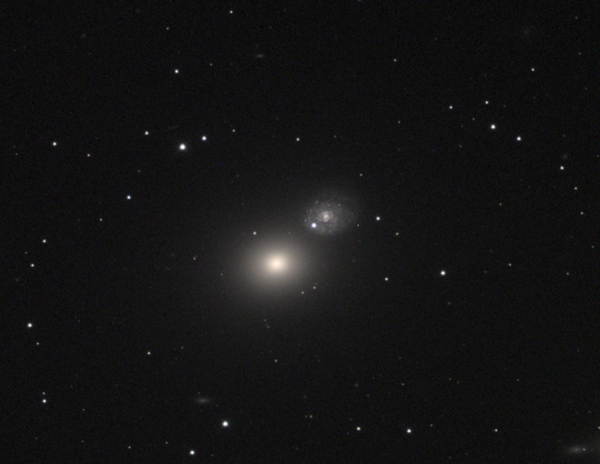
This image of supernova SN2022hrs in NGC 4647 in Virgo was provided by David Davies and taken from Cambridge in the UK. To see more of David's work please visit his Flickr Photostream. Unlike other stars in the image that are in our Milky Way galaxy and are a few tens or hundreds of light-years away, the supernova is 63 million light-years away and is so bright that it almost outshines the galaxy it is in.
Image Details
I've taken great care not to saturate any part of the image, processed the data in Pixinsight, and calibrated the colours with the Photometric Colour Calibration tool.
- Telescope: 8-inch Ritchey-Chretien.
- Camera: QSI 683 camera with Astrodon filters.
- Mount: Skywatcher EQ8.
The data are 20 x 2-min luminance and 12 x 2-min RGB, binned 2 x 2. The location was Cambridge, UK Time: 26 April, 01:30 UT.
David Davies - (26 April 2022).
-
NGC 2683 in Lynx
Took this last night, pity the moon was high as it added quite a bit of noise to the picture. A single shot, 500 second, FLI full frame camera from back garden observatory Northampton. Not quite as good as the Hubble shot!!

The UFO galaxy (NGC 2683) by Richard Weatherley taken from Northampton. Image Details
- Telescope: AG14 Orion F 3.8
- Camera: FLI Microline Camera
Richard Weatherley - (8 April 2022).
-
Messier 68 in Hydra
I keep a list of the Messier objects that I image and M68 is listed as being too low to observe. It reaches around 10.4 degrees of altitude at my location at which point it is skimming just above the branches of the trees at the end of the field behind my observatory. It is visible above the trees for barely an hour. Last night presented an opportunity to try to observe it, but the sky had become very dark with haze and only a few of the brighter stars were visible by eye. Nevertheless, I had a go.
I've recently rediscovered the power of binned exposures with my QSI camera, giving an effective pixel size of 10.8um and an ideal image scale of 1.3"/pixel on my 8" RC telescope. My previous experiments with binned exposures were mixed and I stopped using the technique.
Messier 68 is a globular cluster discovered by Charles Messier in 1780. Messier found it to be unresolvable, but William Herschel first resolved it into stars in 1786. M68 is a rich cluster of around 100,000 stars; it lies at a distance of 33,000 light-years and is around 106 light-years across.

This image of the globular cluster Messier 68 in Hydra is by David Davies and taken from Cambridge in the UK. To see more of David's work please visit his Flickr Photostream. This image is the result of just 10 minutes of exposures each of RGB, 5 x two minutes each, binned 2 x2, as M68 cleared the tops of the trees briefly. Despite atmospheric dispersion, poor sky transparency, horrible seeing and a severely attenuated blue component, I am happy to share the image. I suspect that it is rarely observed in the UK.
Image Details
- Telescope: 8" Ritchey-Chretien
- Camera: QSI 683 with Astrodon RGB filters
- Mount: Skywatcher EQ8.
David Davies - (24 March 2022).